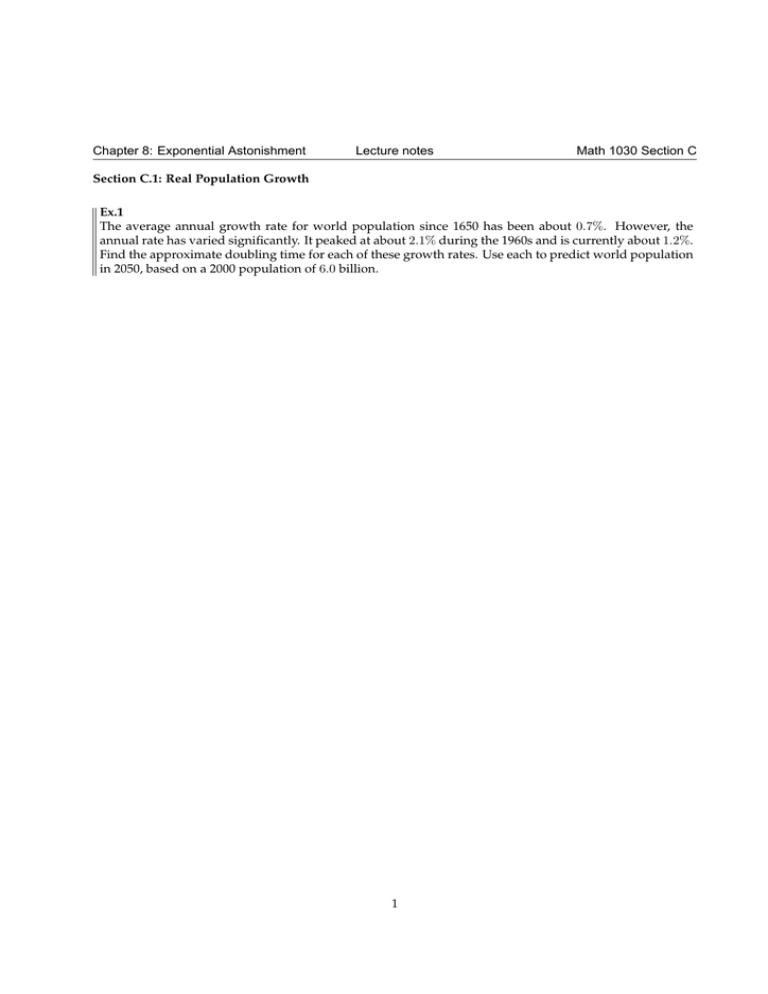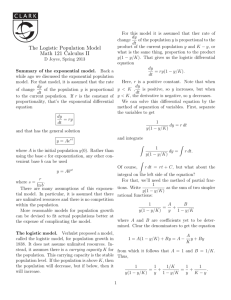Chapter 8: Exponential Astonishment Lecture notes Math 1030 Section C
advertisement

Chapter 8: Exponential Astonishment Lecture notes Math 1030 Section C Section C.1: Real Population Growth Ex.1 The average annual growth rate for world population since 1650 has been about 0.7%. However, the annual rate has varied significantly. It peaked at about 2.1% during the 1960s and is currently about 1.2%. Find the approximate doubling time for each of these growth rates. Use each to predict world population in 2050, based on a 2000 population of 6.0 billion. 1 Chapter 8: Exponential Astonishment Lecture notes Math 1030 Section C Section C.2: What Determines the Growth Rate? Definition of overall growth rate The world population growth rate is the difference between the birth rate and the death rate: growth rate = birth rate − death rate Ex.2 Suppose that on average there are 8.5 births per 100 people and 6.5 deaths per 100 people per year. What is the population growth rate? Ex.3 In 1950, the world birth rate was 3.7 births per 100 people and the world death rate was 2.0 deaths per 100 people. By 1975, the birth rate had fallen to 2.8 births per 100 people and the death rate to 1.1 deaths per 100 people. Contrast the growth rates in 1950 and 1975. 2 Chapter 8: Exponential Astonishment Lecture notes Math 1030 Section C Section C.3: Carrying Capacity and Real Growth Models Definition of carrying capacity For any particular species in a given environment, the carrying capacity is the maximum population that the environment can support. Logistic Growth and Overshoot and Collapse Logistic growth and overshoot and collapse Exponential growth cannot continue indefinitely. Indeed, human population cannot continue to grow much longer at this current rate, because we would be elbow to elbow over the entire Earth in just a few centuries. Theoretical models of population growth assume that human population is limited by the carrying capacity. Two important models for populations approaching the carrying capacity are (1) a gradual leveling off (logistic growth); (2) a rapid increase followed by a rapid decrease (overshoot and collapse). Definition of logistic growth A logistic growth model assumes that the population growth gradually slows as the population approaches the carrying capacity. When the population is small relatively to the carrying capacity, the logistic growth is exponential with a growth rate close to the base growth rate r. As the population approaches carrying capacity, the logistic growth rate approaches zero. The logistic growth rate at any particular time depends on the population at that time, the carrying capacity, and the base growth rate r: population logistic growth rate = r × 1 − carrying capacity 3 Chapter 8: Exponential Astonishment Lecture notes Math 1030 Section C Ex.4 Assume that the Earth’s carrying capacity is 12 billion people. Given that the population growth rate peaked in the 1960s at about 2.1% when the population was about 3 billion, is it reasonable to assume that human population has been following a logistic growth pattern since the 1960s? Is it reasonable to assume that population has been growing logistically throughout that past century? Explain. We need to compare the 2006 growth rate of about 1.2% (see Example 1) to the growth rate predicted by a logistic model. Since 1.3% is close to the current growth rate (1.2%), it is reasonable to say that human population has been growing logistically since the 1960s. However, human population has not been following logistic growth over longer periods. Logistic growth requires a continually decreasing growth rate, which is consistent with the growth rate peaking in the 1960s. In conclusion, it is still too early to know whether the growth rate is logistic or not. Definition of overshoot and collapse A logistic model assumes that the growth rate automatically adjusts as the population approaches the carrying capacity. However, because of the astonishing rate of exponential growth, real population often increase beyond the carrying capacity in a relatively short period of time (overshoot). When a population overshoots the carrying capacity of its environment, a decrease in the population is inevitable. If the overshoot is substantial, the decrease can be rapid and severe (collapse). 4








